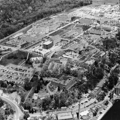Breaking with the city grid, the sinuous Kentmere Parkway was meant to connect the two new parks, Brandywine and Rockford. William P. Bancroft, who donated the latter, designed a 150-foot-wide parkway in 1889 and sent the blueprint to John C. Olmsted in Boston, who corrected it with a more graceful curve. The aging master Frederick Law Olmsted visited Wilmington in December 1892 to meet with William Canby of the Park Commissioners to discuss the delays in implementation of the scheme—owing, he thought, to mutual misunderstanding. In driving over the parkway, Olmsted saw that his plans had been deviated from, the Wilmington parties having proceeded without him in 1891. Impatient with continuing slow response from the Olmsteds, the park board severed ties in 1893.
Kentmere Parkway is lined with expensive homes of the early twentieth century. At the northern end is a statue, cast in England, of Wilmingtonian Thomas F. Bayard (1907, Michael Stillman; Effie Stillman Ritchie, sculptor). Farther on stand the lightning-scarred nineteenth-century oaks of Rockford Grove.
On the west side of Rockford Road is Rockford Park. Bancroft, who prevailed upon the state legislature to form the Wilmington Board of Park Commissioners in 1883, provided land for the park in 1889 and 1895, totaling some 200 acres. In the latter year, Du-Pont donated the steep, scenic hillside overlooking today's Experimental Station (BR25), where now sits the William M. Canby Memorial—a bench of Barre, Vermont, granite designed by a leading Boston architect (1905, Guy Lowell). Canby, president of the park board, was a botanist who once visited Alaska with John Muir, who attended the park's dedication. Historian Priscilla M. Thompson wrote in 1978, “Scholars do not consider the Wilmington parks to be one of [Frederick Law] Olmsted's significant projects, and yet his influence and genius is inescapable. He suggested acquisition of Brandywine Park; he made a plan for Kentmere Parkway; and his firm unofficially advised and planned Rockford Park on William Bancroft's blueprint.” A statue of Civil War Admiral Samuel F. Du Pont (1884, Launt Thompson) was moved to the park from Du Pont Circle, Washington, in 1920, when displaced by a fountain.
Rapid urban growth demanded a water tank on Mount Salem Hill, encased in a decorative, 115-foot tower with round-arched observation deck atop. Construction of Rockford Tower 1899–1900 made use, in part, of boulders from old farm walls on the park grounds. Some of the stones are truly cyclopean. Edge Moor Bridge Works provided the 500,000 gallon steel tank (replaced 1983–1984). The interior of the Norman-style tower was lined with white-glazed brick, and the roof was supported by a spidery metal truss system (restored 2002, MGZA). When Rockford Tower opened, ten million gallons flowed through the tank annually—compared to four million gallons daily at present, so greatly has water demand increased.
Writing Credits
If SAH Archipedia has been useful to you, please consider supporting it.
SAH Archipedia tells the story of the United States through its buildings, landscapes, and cities. This freely available resource empowers the public with authoritative knowledge that deepens their understanding and appreciation of the built environment. But the Society of Architectural Historians, which created SAH Archipedia with University of Virginia Press, needs your support to maintain the high-caliber research, writing, photography, cartography, editing, design, and programming that make SAH Archipedia a trusted online resource available to all who value the history of place, heritage tourism, and learning.


